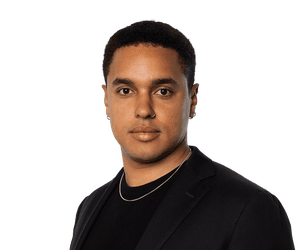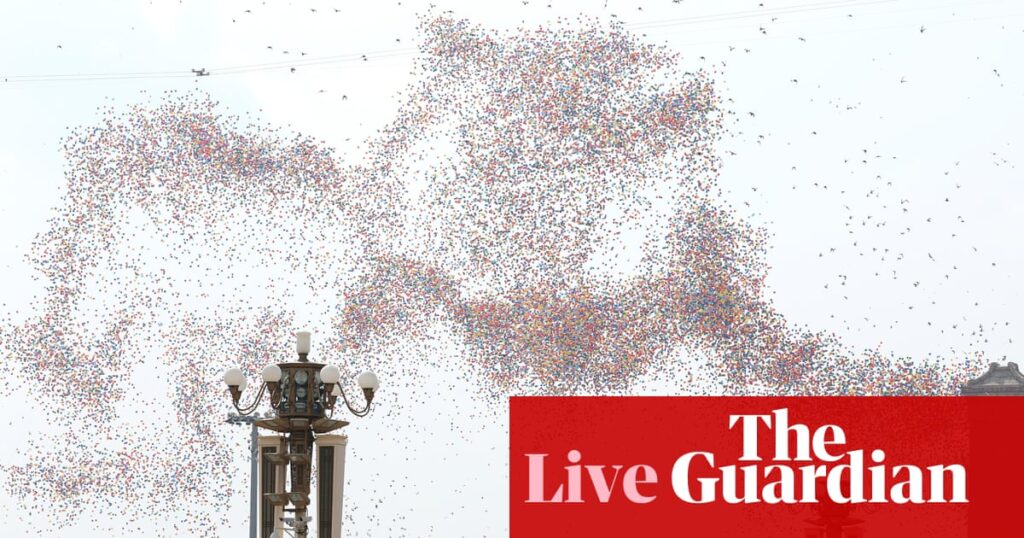Xi, Kim, Putin appear together
The leaders of China, Russia and North Korea have been photographed walking to the parade together. It is a striking image, that has been beamed onto large screens in Beijing.
Key events
There were almost no western leaders among the 26 foreign heads of state attending the victory day parade, despite China’s partnership with the Allied powers in the Pacific Theatre during the second world war.
There was an exception in the invite of Robert Fico, prime minister of Slovakia – a member of the European Union. Serbia’s president Aleksander Vucic also attended the parade.
The Serbian and Slovakian leaders are both friendly with Russia.

Helen Davidson
As the dignitaries filed in – with Xi, Putin and Kim in the lead – the state media broadcast noted the presence of war veterans, including some from Taiwan.
The anniversary has underscored some less-discussed aspects of the Taiwan China tensions.
The second world war came to China – then known as the Republic of China (ROC) – while the country was in the midst of its own civil war, between the ROC rulers, the Kuomintang, and the newly formed Chinese Communist party. The two sides paused their battle fight alongside each other against Japan.
After Japan surrendered, Taiwan, which had been ruled by Japan, was returned to the ROC. But the civil war had resumed, and soon, the CCP took control of the mainland and the ROC’s KMT leaders fled to Taiwan. The CCP established the People’s Republic of China, and the KMT established the ROC government in exile, intending to regroup and one day retake the mainland (spoiler: they didn’t).
This is the very simplified background to the CCP’s claim over Taiwan today.
But when it comes to the second world war, the two sides are also in dispute over who really led the fight against Japan.
Beijing has mounted a campaign to emphasise the “correct view” of the history, emphasising that China and Soviet Russia played a pivotal role, and claiming that the CCP’s wartime efforts were “deliberately belittled and vilified”. Throughout the summer cinemas showed blockbusters that celebrated the battles fought by China against fascist aggressors, prompting a wave of patriotism among viewers.
In Taiwan, officials say the fight was mostly led by the KMT and its leader, Chiang Kai-shek, noting that they were the ones to sign peace agreements as allied nations.
“During the Republic of China’s war of resistance against Japan, the People’s Republic of China did not even exist, but the Chinese communist regime has in recent years repeatedly distorted the facts, claiming it was the [Chinese] Communist Party who led the war of resistance,” Mainland Affairs Council minister Chiu Chui-cheng said last month.
The council said the communists’ strategy at the time was “70% about strengthening themselves, 20% dealing with the Nationalist government and 10% about opposing Japan,” repeating an old wartime accusation against Mao the CCP has denied.
A new photograph has emerged showing Dan Andrews, the former Labor premier of the Australian state of Victoria, standing among global leaders before the parade.
You can spot him in the back right corner, behind Putin, Xi and Kim.
Another former Labor state premier, Bob Carr of New South Wales, is also reportedly a guest at the parade.
Critics, including opposition leader Sussan Ley, say the pair risk being used in CCP propaganda.
But Carr told The Australian his attendance was in recognition of China and Australia’s shared second world war history, arguing that Chinese resistance defended Australia from direct naval assault by Japan.
Carr led the Australia-China Relations Institute at the University of Technology Sydney from 2014 to 2019.
Andrews signed Victoria on to China’s belt and road initiative, before it was vetoed by the Morrison government.
Military hardware on display

Helen Davidson
There’s an extraordinary amount of military hardware on display.
We’ve seen everything from tanks and drones to long-range and nuclear capable missiles, fighter jets and stealth aircraft. The long-distance nuclear capable H6 bombers, and the J-16 and J-20 fighters (most often seen running harassment sorties into Taiwan’s air defence identification zone) are among the planes doing flyover displays above the square.
New stealth fighters are also flying V formations, a livestream from inside cockpits showing pilots giving a salute as they fly past.
Military equipment passes during the military parade to commemorate the 80th anniversary of Japan’s World War II surrender held in front of Tiananmen Gate in Beijing, Wednesday, Sept. 3, 2025. Photograph: Ng Han Guan/AP
There were reports of the J15-DT – China’s new carrier-based electronic warfare also appearing. The development of the new aircraft has been closely watched by military observers.
The Dongfeng-61 missile was noted by some analysts.
It is a hypersonic, road mobile missile with a vertical erector, which one analyst said made it “much harder to spot and therefore hit prior to launch”.
“Being a hypersonic, it’s much harder to track and shoot down before it hits its target,” the analyst said
Drew Thompson, a senior fellow at the S. Rajaratnam school of international studies said:
The parade is a clear demonstration of the PLA’s expanding capabilities in both strategic and conventional domains which is intended to give the United States, Europe and China’s neighbours pause should they consider challenging China’s core national interests.
Zhou Bo, a retired senior Chinese army colonel, said the parade was “eye-opening” in terms of China’s advancement.
He said the ICBMs – Intercontinental ballistic missiles – are impressive but seen before.
The JL3 ICBM, which can be launched from under the sea, “is something new” and “very impressive”, he told China’s state media CGTN.
Parade ends
The parade has now ended, balloons are being released into the sky en masse.
For readers who are not hardware-heads, a new range of military equipment is making its public debut today.
An aerial display of military aircraft is moving through the sky in a V formation, leaving a trail of brightly coloured smoke.
A flock of doves has just been released into the sky.
Let’s take a look at some of the hardware on display today:
Snap analysis: Xi’s speech

Helen Davidson
Xi Jinping’s short speech praised the “huge national sacrifice” of the Chinese people in fighting the war, but it also contained messages for today’s world.
Chinese people rallied together to defy the enemy … Today humanity again has to choose between peace and war.
He said China was a great nation which “is never intimidated by any bullies and always values independence and forges ahead”, according to the state media translation. He said the past showed that Chinese people always rally together “to defy the enemy” when faced with adversity.
Xi’s speech contained several references to the “rejuvenation of the Chinese nation” – a common phrase for Xi’s overarching plan for China’s future which hinges on Taiwan.
Xi and the CCP claim Taiwan is a Chinese province, now run by illegal separatists, and he has vowed to annex it under what he terms “reunification”. Taiwan’s government and people are opposed to this.
But Xi’s speech, while not specifically referencing Taiwan, makes it very clear that it’s still high on his agenda. He has pledged that China will take Taiwan by military force if necessary – and the parade display is also a strong demonstration of military capabilities.
The People’s Liberation Army (PLA) has been undergoing modernisation under Xi, but it is also been beset by corruption issues, and in the last few years there have been purges of officials and personnel at levels not seen since the Mao Xedong era.
Xi seemed to reference that in his speech too, with a line that could be read as reassurance to people worried about it, and a warning to those inside the force.
The Chinese People’s Liberation Army has been and always will be the heroic armed forces that the party and the people can fully trust and rely on. All service members should faithfully perform their sacred duties, speed up the building of a world class military, and firmly safeguard China’s sovereignty, unity and territorial integrity.
Read more about the significant meeting of Xi, Putin and Kim here:
As the parade takes place, with Vladimir Putin in attendance, it is worth noting that all of Ukraine is under air raid alerts following Ukrainian air force warnings of Russian missile and drone attacks, military data shows.
Xi has returned to his seat overlooking the parade.
He is now peering up at the sky, where military aerial formations are flying.

Blake Sharp-Wiggins
Some images as the parade gets under way.

Rebecca Ratcliffe
As the parade continues, a look at one of the notable guests in attendance.
Myanmar’s junta chief Min Aung Hlaing, who rarely travels abroad, is also in Beijing.
For Min Aung Hlaing, Beijing is a rare and crucial ally, and his visit to China – months ahead of controversial promised elections – is an important diplomatic opportunity.
Min Aung Hlaing has become increasingly isolated abroad since he seized power in a coup in 2021 – a disastrous move that provoked a defiant armed opposition movement and spiralling conflict.
Many Western countries downgraded relations and imposed sanctions in response to the coup, and the UN has repeatedly warned of possible war crimes and crimes against humanity by the military.
Steps taken by western countries have had little impact on the military’s actions. Instead China retains far greater influence over what happens next.
China sells weapons to and is an ally of the military, though their relationship is complicated. Beijing was displeased by the coup in 2021, fearing the military’s seizure of power would create instability, and threaten China’s economic investments and its strategic interests.
Over the years, it grew increasingly frustrated at Min Aung Hlaing’s inability to control the country and impose order. It has been especially concerned by the explosion in organised crime in Myanmar, with which it shares a border – especially the proliferation of “scam compounds” that have trafficked large numbers of Chinese nationals, and targeted the Chinese public with online scams.
Frustration prompted Beijing to give its tacit support to a 2023 offensive in northern Shan State by a coalition of ethnic armed groups that opposed the junta. However, when the success of this offensive looked like it might create a domino effect, and ultimately threaten the military’s grasp on power, China stepped up its support for the junta. It apparently feared the collapse of Min Aung Hlaing’s regime could ultimately be even worse for China’s interests.
China has since increased its diplomatic engagements with the junta, and has backed the junta’s plans to hold elections, due to be held in phases, starting 28 December. Many western governments will perceive the vote as a sham, but Min Aung Hlaing will hope the vote will lead to a reopening or normalisation of diplomatic relations with some regional countries. India, as well as China, have signalled support for the vote.
What is at stake for Kim Jong-un?

Justin McCurry
Kim Jong-un has not left North Korea for two years, while it has been six years since he last visited China. The North Korean leader does not seem to share his father Kim Jong-il’s fear of flying – he flew to Singapore to meet Donald Trump in 2018 – but he could hardly be described as an enthusiastic traveller. So why has he decided to go to Beijing – again in a heavily armoured train – to attend Wednesday’s military parade?
Having once been isolated as part of George W Bush’s “axis of evil”, North Korea has exploited changes in the global geopolitical landscape to come out of the cold, triggering concern in South Korea and Japan. Now it is one third of what western analysts are calling an “axis of upheaval” along with China, Russia and Iran.
While the Trump administration invites a backlash through punitive trade measures imposed on traditional allies, Kim has improved his regime’s ties with Xi Jinping and Vladimir Putin. Reports that Kim and Putin will sit either side of Xi at Wednesday’s military parade to commemorate 80 years since Japan’s defeat in the second world war will be irrefutable evidence of a trilateral relationship designed to issue a direct challenge to what they see as western hegemony.
Kim’s friendship with Putin, whom he met in Russia in 2023 and again in Pyongyang last year, has proved useful for both leaders. Kim has sent thousands of his troops to fight alongside Russian forces against Ukraine – a show of support that has reportedly given him access to Russian expertise in developing weapons of mass destruction.
Kim’s relationship with Xi is more complicated. The Chinese leader has appeared more reluctant to antagonise the US through moving dramatically closer to Pyongyang, but China is still the North’s biggest aid donor – a role Kim is keen to build on for the sake of his country’s perennially struggling economy.
Kim is also wary of the recent thaw in ties between China and South Korea, prompting some analysts to speculate that his presence at the parade is a pre-emptive move to frustrate any potential meeting of minds between Xi and the South’s new president, Lee Jae-myung.
While Russia continues to attract international condemnation over its invasion of Ukraine, an unambiguous show of Chinese support for North Korea would represent a diplomatic coup for Kim – and make his long train journey to and from Beijing worth the effort.
A successful trip to the Chinese capital could result in a reciprocal visit by Xi to Pyongyang in October for the anniversary of the founding of North Korea’s ruling Workers’ party, according to Lim Eul-chul, a professor at the Institute for Far Eastern Studies Kyungnam University in South Korea. “If Kim succeeds in securing Xi’s visit, it would raise the regime’s status to its highest level,” Lim said.
Trump sends ‘warmest regards’ to Xi, Putin and Kim ‘as you conspire against’ the US
US president Donald Trump is clearly aware that the parade is taking place. He has posted to Truth Social about it:
“The big question to be answered is whether or not President Xi of China will mention the massive amount of support and “blood” that The United States of America gave to China in order to help it to secure its FREEDOM from a very unfriendly foreign invader. Many Americans died in China’s quest for Victory and Glory. I hope that they are rightfully Honored and Remembered for their Bravery and Sacrifice! May President Xi and the wonderful people of China have a great and lasting day of celebration. Please give my warmest regards to Vladimir Putin, and Kim Jong Un, as you conspire against The United States of America. PRESIDENT DONALD J. TRUMP”
Marching has begun by the People’s Liberation Army (PLA).
Xi is riding in an open-topped car, surveying the troops.
Snap analysis on the Xi, Putin, Kim photo

Justin McCurry
It is an image that, had it been published just a few years ago, would have been dismissed as a piece of mischievous photo-shopping: the leaders of Russia and China, accompanied by the head of a pariah regime whose mission to arm his country with nuclear weapons had been opposed in the United Nations by his two companions.
But dramatic shifts in the geopolitical landscape – Russia’s invasion of Ukraine and, crucially, the re-election of Donald Trump – have combined to bring Xi Jinping, Vladimir Putin and the North Korean leader Kim Jong-un together.
On Wednesday morning, the three men led a group of more than 20 world leaders as they strode towards a rostrum in Tiananmen Square in Beijing to watch a “victory day” parade in Beijing.
Xi Jinping, dressed in a grey Mao suit and flanked by Putin on his right and Kim on his left, is presiding over what could justifiably be described as proof that a second cold war has begun – led by a triumvirate of nuclear powers that have positioned themselves in diametric opposition to the US and its allies in the west.
The symbolism attached to the first-ever meeting between the three leaders threatened to overshadow the huge military parade snaking through the streets of the Chinese capital.
Just how the photo op will translate into action remains to be seen, but one world leader not on Wednesday’s guest list must surely be looking on with a mixture of curiosity and alarm.
Xi’s address continues:
History cautions us that humanity rises and falls together… Today humanity has to choose between peace and war.
He vows to speed up the building of a world class military, which is met with applause.
The Chinese nation is never intimidated by any bullies.
The speech has concluded, we will continue to keep you up to date.
Xi’s speech begins
Xi Jinping is welcoming guests to the parade and delivering a speech.
He welcomes guests from around the world and says the parade is an occasion to remember history and “cherish peace” – paying tribute to veterans and soldiers.
Xi goes on to talk about China’s achievements in the second world war.


